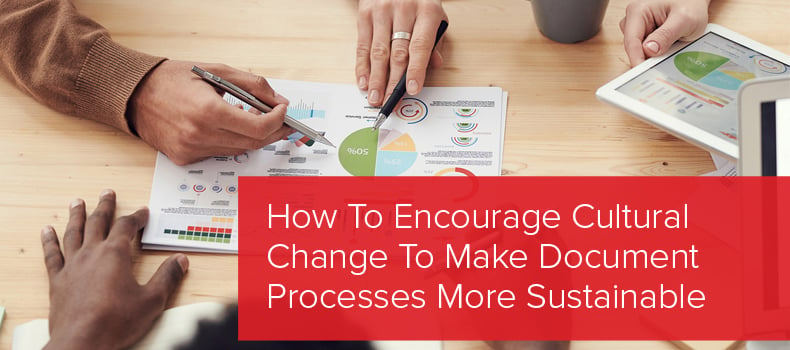Stay up to date with our latest news and insights
Supporting description on the types of content that feature in the blog.
23 March 2021

Change; Sometimes seen as a dirty word that people fear, other times, it’s a way to motivate people and help set-out a path to better and brighter things. Hopefully, in your company, it’s more often used for the latter.
Change is notoriously difficult to implement in medium and large organisations, stemming from processes being in place for a long time and people not wanting to move away from tried and trusted ways. The issues with this? Processes that don’t change can become inefficient and fragmented over time. Change and optimisation help to make these processes efficient.
In this case, we’re talking about cultural change and specifically in relation to document processes with the aim of making them both more efficient and more sustainable.

During the months of lockdown and pandemic living, many were forced to work from home in an attempt to stop the virus from spreading (and rightly so!), and while it was an odd transition, a lot of people now confess to wanting to work from home in the future. In fact, “almost 90% would like to continue working from home in some capacity, with almost half wanting to work at home often or all of the time” (Coronavirus: 'Nine in 10 would continue working from home', BBC).
Essentially, with so many people adapting to work from home, and learning to access and work with documents remotely, some of the change you can promote internally has already happened - it’s now just about making it stick as people come back to the office full-time.
Before you start to roll out the tools and ideas for change management (see below), you might be interested to learn more about why people use paper and printed documents, and what some of the alternatives are so you can encourage the shift to digital document management and processes - click here to read more about that!
If you’re in need of more than a friendly nudge as people come through the office doors, then it might be time to consider other options that help change people’s attitudes towards printing and document usage.
One very simple thing you can do is to add a line to your email signature asking people not to print documents or emails unless necessary - it might be a small gesture but can have an impact, especially if you add to the note a line about sustainability or protecting the environment!
Next, you have software options - this is where you can really start to drive change and show people how to optimise their document processes.
Software like Control Suite can prompt people to use digital correspondence instead of paper, for example, if someone tries to print a letter. This prompt helps to make people think differently when they’re actioning a task. If you go to print something and you get a note saying ‘do you really need to print this?’, it might make you think twice before actually printing.
Along the same lines of nudges is to provide a tool that makes everyone responsible for their own printing and document processes, including measuring and monitoring their own paper usage.
The Print Awareness Tool does exactly this, while adding in elements of ‘gamification’ to appeal to peoples’ competitive instinct and actively encourages the desired change in user behaviour.
The tool uses a simple graphical interface to show users their print history, key stats and how they compare with their peer group, department and the entire organisation. This awareness helps people realise just how much they’re printing and encourages them to reduce that printing, thus helping the environment.
These changes can go along way in reducing printing and also changing people’s attitudes and processes for document management. The more employees that get onboard with these simple changes, the more sustainable your organisation’s document processes can become.
We understand that change isn’t always easy to implement, however, with the drastic changes we’ve all seen during the Covid-19 pandemic in 2020, we all know it’s possible.
Supporting description on the types of content that feature in the blog.

20-09-2024
Digital document management tools offer a range of compelling benefits for businesses, including a PDF editor, a file converter and a form generator. You can also integrate with digital signatures qui...

20-09-2024
When choosing a SaaS software to deal with your company’s PDF documents and enable forms to be digitally sent and signed, you’ll want a product that’s user-friendly and easy to use. With Tungsten’s Po...

11-07-2024
Belkin is a global technology company that provides high-quality electronics products, from wireless chargers to power banks. Their people-centric approach and best-in-class functionality have positio...